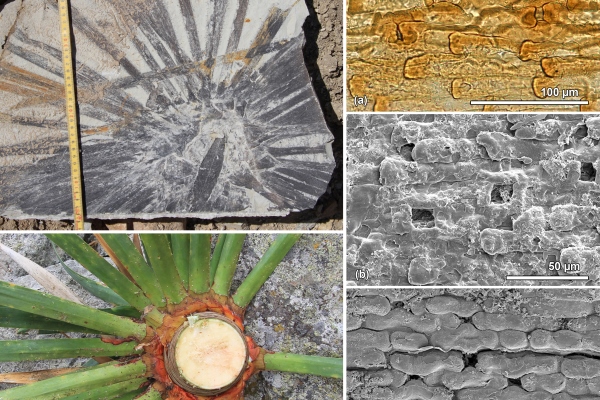The Evolution of Distribution Patterns in Flowering Plants

Dragon trees from the Miocene of Anatolia (upper leaf rosette and leaf epidermal characters in top and middle right and their modern Macaronesian counterpart Dracaena draco (lower leaf rosette and leaf epidermal features on lower right) (from Denk et al. 2014)
Summary
This project will use the fossil record of plant lineages that occurred in temperate regions during large parts of the Cenozoic in order to investigate the relative roles of niche conservatism and niche evolution to the change of distributional patterns in these lineages through time. Fossil plant assemblages from the western and eastern Mediterranean regions will be investigated spanning the period from the Oligocene to the Pliocene (34 to 2.6 million years ago).
The distribution of plant lineages commonly has changed through geological times. Distribution ranges change because of two major processes:
- Niche evolution associated with biome shifts (lineages evolve and disperse into new habitats)
- Niche conservatism, where range change is related to the geographic dislocation of a plant lineage’s niche due to climate change and other abiotic factors
The distinction of these processes is essential in order to understand how woody angiosperms (trees and shrubs) responded to past and will respond to ongoing environmental changes. It is also essential when attempting to trace the emergence of major new biomes in the history of earth.
The aim of the project is to understand the adaptive radiation of once (humid) temperate plant groups into a wide range of modern biomes including tropical, seasonal summer-dry, and arid biomes. This will be achieved by integrating available phylogenetic studies with information from key fossil plant taxa and exceptionally rich fossil plant assemblages.
High-resolution taxonomic assessments making use of macroscopic and microscopic morphological features of plant fossils will form the basis for detailed investigations of potential niche evolution or niche conservatism.
Addressing these research questions using an integrated historical and modern approach is highly innovative as it will be relevant to many palaeoecological studies and to understanding responses of today’s north temperate woody vegetation to ongoing environmental shifts.
This research is funded by the Swedish Research Council (VR)
Project Participants at the Museum
External Project Participants
University of Istanbul, Turkey
University of Vienna, Department of Palaeontology, Austria
Athens University, Department of Geology and Geoenvironment, Greece
Palaeontological Institute, Russian Academy of Sciences, Russia


